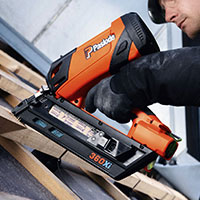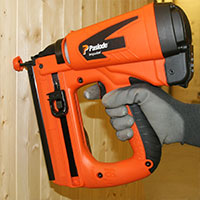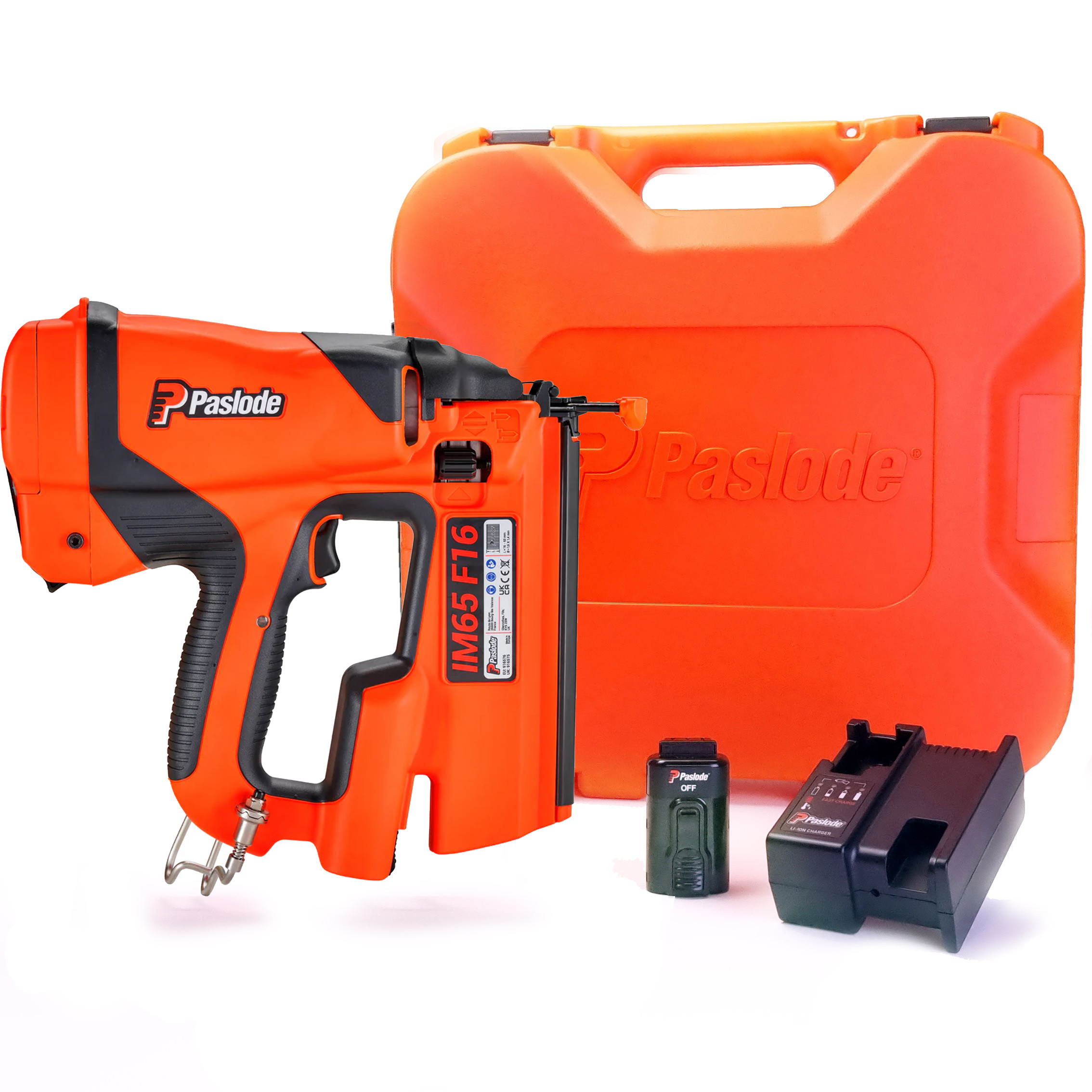Nail Gun Buyers Guide [2025]
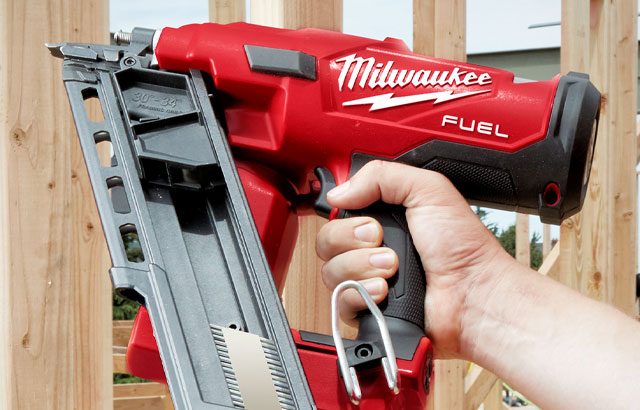
This Nail Gun Buyers Guide will cover the various types of wood to wood nail guns available and highlight the advantages and disadvantages of cordless battery powered versus gas powered nail guns.
The convenience of not having a cord or air hose attached to your nail gun has propelled the popularity of cordless nailing tools but choosing the best cordless nail gun for your application can be confusing – especially with so many options available.
Do I need a framing nailer or a finishing nailer? What about brad nailers? It doesn’t just end with the type of nailing machine; should I choose a gasless nailer or a nail gun that is used in conjunction with gas canisters or ‘fuel cells’?
- What are the different types of nail guns?
- Gas Powered VS Cordless Battery Powered Nail Guns
- What are the advantages and disadvantages of Gas Powered Nail Guns?
- What are the advantages and disadvantages of Cordless Nail Guns?
What are the different types of nail guns?
Selecting the correct nail diameter is critical as too big may split the wood and too small may not hold the material in place.
Framing Nailers
Framing Nailers fire the largest nails, usually from 50mm long up to a maximum of 90mm long. The nail diameters are generally between 2.8mm and 3.1mm and they are usually collated at 34° in the UK, to suit the popular 34° angled magazine on the nail gun. Typical applications include noggin, joists, stud work, timber frame erection, soffits, floor boarding, roof battening, roof decking, panelling, cladding, fencing and truss work.
Protrade recommends
Finishing Nailers
Finishing Nailers fire 15g or 16g nails, which are approximately 1.8mm or 1.6mm in diameter – it’s worth noting that the higher the gauge, the thinner the nail. The length range differs from machine to machine, but the common sizes of nails are between 15mm and 64mm long. Finishing nail guns are available with a straight magazine or a 20° angled magazine.
Our earlier article ‘What is the difference between a straight and angled nailer’? explains the fundamental differences, advantages and disadvantages between the two versions. Typical applications for finishing nailers include tongue and groove panelling, crown mouldings, architraves, beading, dado rail, skirting boards and window casings.
Protrade recommends
Brad Nailers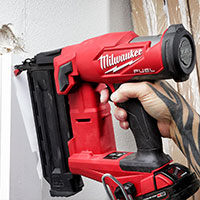
Brad Nailers commonly fire 18g nails, which are approximately 1.2mm in diameter. Just to confuse matters, 16g nails are often described as brad nails, so always double check the gauge when purchasing your nails. 18g brad nails are usually straight, as the nail magazines are not angled, ranging in length from 10mm up to around 50mm.
Typical applications for brad nailers are very similar to those of finishing nailers, but the thinner 18g nail is better for delicate trims, lightweight boards and mouldings – ensuring the material does not split. The resulting hole following the insertion of the nail, is also much smaller and may not require filling afterwards.
Protrade recommends
Gas Powered VS Cordless Battery Powered Nail Guns
Paslode invented the cordless gas-actuated nail gun back in 1986. At the time, their innovative ‘impulse technology’ was the first credible alternative to the pneumatic solutions that required air hoses and compressors and it was the only cordless nailing solution, except for the traditional hammer of course. More recently, cordless battery-powered nail guns have entered the marketplace, eliminating the need for a gas canister or fuel cell.
The early battery-operated gas-free models featured spring-loaded mechanisms or electromagnetic designs, that forced the piston to drive the nail into the workpiece. Unfortunately, these technologies lacked power, compared to gas-powered alternatives, meaning nails would often stand proud in harder timber materials. The recoil generated when firing, was also significantly greater, causing user discomfort. For these two reasons, the early cordless nail guns never really took off.
More recent gas-free nail guns combine both cordless and pneumatic technology. An internal permanently sealed air cylinder stores energy, and every nail is simply driven by compressed air. A battery-powered motor then returns the driver to the ready position. Ramp-up time is significantly reduced, compared to early gas-free models, meaning up to three nails can be fired per second. Power is also increased, whilst recoil has been reduced. For example, the latest generation Paslode II IM350+ Lithium has a quick charge Li-ion+ battery that can provide up to 9,000 shots per single charge, 200 shots in just 2 minutes.
Most modern gas-free nail guns, across reputable power tool brands, have now adopted this new and improved cordless battery technology. The battery-powered cordless nail guns are now rivalling the gas-powered models, when it comes to performance and portability.
What are the advantages and disadvantages of Gas Powered Nail Guns?
Advantages of gas powered nail guns:
- Between 30 – 40% lighter in weight compared to cordless battery powered nail guns.
- Up to 13,000 fixings per battery charge compared to circa. 1000 with cordless nailers.
- There’s little that can go wrong, so the cost of servicing is often less.
- Consistent power and performance for long periods of time.
Disadvantages of gas powered nail guns:
- Nail & fuel packs cost more compared to just the boxes of nails.
- Additional waste with empty gas canisters.
- Performance of some gas canisters can be affected by cold weather, although the Paslode SERIES-i fuel cell does work down to -15°C.
- Due to the build-up of carbon, the nail gun will need stripping down and cleaning periodically, although a Paslode is every 50,000 shots – which is substantial.
What are the advantages and disadvantages of Cordless Nail Guns?
Advantages of cordless nail guns:
- Boxes of nails cost less compared to nail & fuel packs.
- More ecological as there is no additional waste with empty gas canisters.
- There are no problems with cold weather performance.
- The tool can be part of your cordless family of power tools, utilising the same battery.
Disadvantages of cordless nail guns:
- The internal air cylinder will lose pressure after around 30,000 shots is some instances, resulting in a relatively costly repair and potentially a long period of downtime.
- Between 30 – 40% heavier in weight compared to gas powered nail guns.
- Around 1000 fixings per charge compared to up to 13,000 with gas powered nailers.
- Not all cordless battery platforms feature a full range of cordless nail guns.
Summary
Is a gas powered or cordless nail gun better?
The latest developments in cordless nail guns that don’t require fuel cells, has certainly closed the gap compared to gas powered nailers. Performance levels are very similar with both types firing 2 – 3 nails per second. The two biggest issues with cordless battery powered nail guns are the weight, with a 30 – 40% difference, and the number of shots before maintenance is required.
If you use your nail gun for long periods of time, especially in overhead applications, the increased weight will be noticeable and it’ll really take it’s toll on your shoulder and arm. Add to this approximately 50,000 shots versus 30,000 before a potential service, means I would choose a gas powered nailer for frequent users that fire fairly large volumes of nails
If you use your nail gun every now and then, and a model is available that matches your chosen cordless battery platform, I’d go with the cordless nail guns.

Joint Managing Director, Protrade
Craig has over 30 years of experience at Protrade, working in various departments including sales, procurement, and marketing, and ultimately becoming Managing Director in 2008. Following the merger of Protrade and Joinery Fit-Out Supplies in 2018, Craig is now the joint MD of the company.

